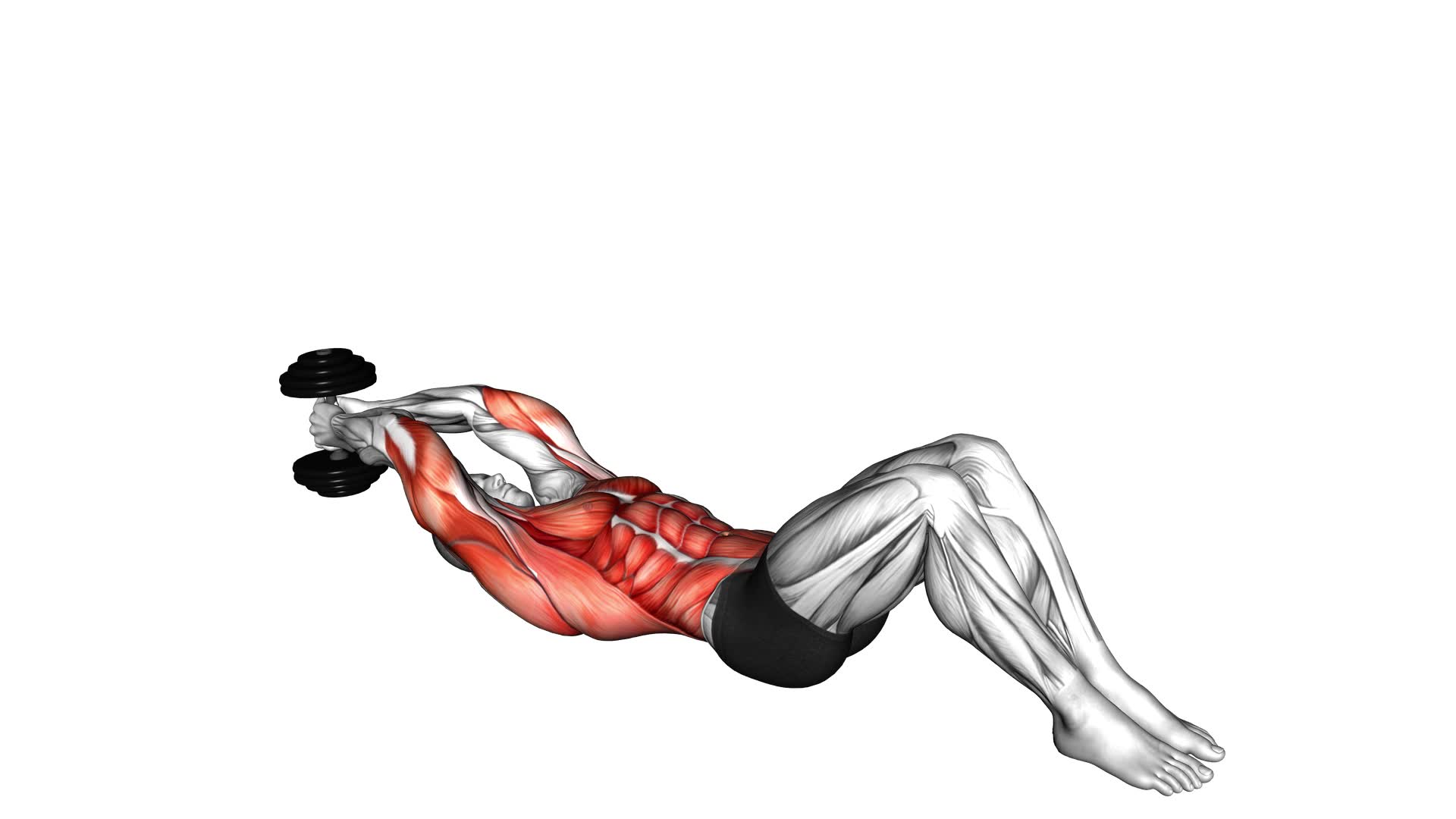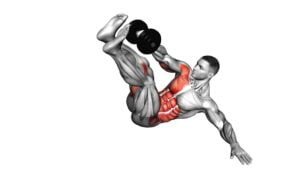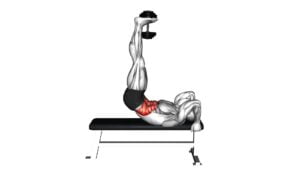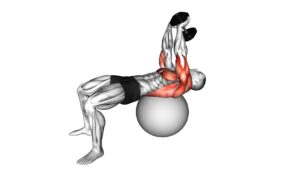Dumbbell Lying Woodchop – Video Exercise Guide & Tips

Get ready to tone your core and strengthen your muscles with the Dumbbell Lying Woodchop!
Watch This Exercise Video
This video exercise guide will show you the proper form and technique for this effective workout.
Learn variations to keep things interesting and avoid common mistakes.
Maximize your results with these expert tips.
It's time to take your fitness to the next level with the Dumbbell Lying Woodchop.
Let's get started!
Key Takeaways
- The Dumbbell Lying Woodchop targets and strengthens core muscles.
- It engages abdominal muscles, obliques, and lower back.
- The exercise improves rotational strength and stability in the core.
- It enhances athletic performance.
Benefits of the Dumbbell Lying Woodchop
One of the benefits of the Dumbbell Lying Woodchop is its ability to target and strengthen your core muscles. This exercise is highly effective in engaging your abdominal muscles, obliques, and lower back. By lying on your back and performing this movement, you activate these muscles in a unique and challenging way. The twisting motion involved in the woodchop exercise helps to improve rotational strength and stability in your core.
If you're looking for alternatives to the Dumbbell Lying Woodchop, there are a few options you can consider. One alternative is the cable woodchop, where you use a cable machine instead of dumbbells. This variation provides a constant resistance throughout the movement, making it a great option for building core strength. Another alternative is the medicine ball woodchop, where you use a medicine ball instead of dumbbells. This exercise adds an element of instability, further challenging your core muscles.
Incorporating the Dumbbell Lying Woodchop into your workout routine can help to improve your overall core strength and stability. It targets multiple muscle groups and can be modified to suit your fitness level. Whether you choose to stick with the dumbbell variation or explore alternatives, the woodchop exercise is an effective way to strengthen your core and enhance your athletic performance.
Proper Form and Technique for the Dumbbell Lying Woodchop
To perform the Dumbbell Lying Woodchop with proper form and technique, how should you position your body and grip the dumbbell? When starting the exercise, lie flat on your back with your knees bent and feet planted firmly on the ground. Make sure your head and neck are relaxed, with your lower back pressed into the floor. Hold the dumbbell with both hands, gripping it firmly with your palms facing each other.
Now, let's address some common mistakes and offer tips for beginners. One common mistake is using too heavy of a weight. It's important to start with a manageable weight that allows you to maintain proper form throughout the exercise. Another mistake is rushing the movement. Remember to move slowly and with control, focusing on engaging your core muscles.
For beginners, it's important to start with a lighter weight and gradually increase the resistance as you become more comfortable and confident in your form. Additionally, it's crucial to engage your core muscles throughout the entire movement to protect your lower back and maximize the effectiveness of the exercise.
Variations of the Dumbbell Lying Woodchop
Now let's explore different ways to modify the Dumbbell Lying Woodchop exercise to add variety and challenge to your core workout.
Here are some weighted woodchop variations and alternative core exercises that you can try:
- Weighted Woodchop Variations:
- Standing Woodchop: Instead of lying on the ground, perform the woodchop motion while standing. This engages your core and adds an extra challenge to your balance and stability.
- Medicine Ball Woodchop: Hold a medicine ball instead of dumbbells while performing the woodchop. The added weight will intensify the exercise and work your core muscles even more.
- Alternative Core Exercises:
- Russian Twist: Sit on the ground with your knees bent and feet lifted off the floor. Hold a weight or medicine ball in front of your chest and twist your torso from side to side, engaging your obliques.
- Plank with Knee Tucks: Start in a high plank position and bring one knee towards your chest, then alternate sides. This exercise targets your entire core, including your abs, obliques, and lower back.
Common Mistakes to Avoid During the Dumbbell Lying Woodchop
To maximize the effectiveness of the Dumbbell Lying Woodchop exercise, it's crucial to be aware of and avoid common mistakes. Proper form is essential to ensure that you're targeting the correct muscles and avoiding injury.
One common mistake to avoid is using too much weight. It's important to start with a weight that you can comfortably handle and gradually increase as your strength improves. Using excessive weight can compromise your form and put unnecessary strain on your muscles and joints.
Another mistake to watch out for is twisting your body too much. The movement should primarily come from your core muscles, with minimal rotation of your hips and shoulders. Twisting excessively can lead to strain and potential injury.
Additionally, it's important to maintain a controlled and steady pace throughout the exercise. Avoid using momentum to swing the dumbbell, as this takes away from the effectiveness of the exercise and increases the risk of injury.
Lastly, make sure to keep your core engaged and your back flat on the floor throughout the movement. Arching your back or allowing it to lift off the floor can strain your lower back and diminish the benefits of the exercise.
Tips to Maximize Your Results With the Dumbbell Lying Woodchop
To get the most out of the Dumbbell Lying Woodchop, focus on proper technique and incorporate these tips to maximize your results:
- Use the right equipment: Make sure you have a dumbbell that's suitable for your strength level. Starting with a weight that's too heavy can lead to injury, while a weight that's too light won't provide enough resistance to challenge your muscles effectively.
- Avoid common misconceptions: One common misconception about the Dumbbell Lying Woodchop is that it only targets the abs. While it does engage your core muscles, it also works your shoulders, back, and hips. This exercise is a full-body movement that can help improve your overall strength and stability.
Frequently Asked Questions
Can the Dumbbell Lying Woodchop Be Performed With a Kettlebell Instead of a Dumbbell?
Yes, you can substitute a kettlebell for a dumbbell when performing the lying woodchop exercise. This modification can add variety and challenge to your workout routine.
However, it's important to note that using a kettlebell may require a slightly different grip and positioning.
Additionally, if you have lower back issues, it's important to consult with a fitness professional to ensure proper form and to determine any necessary modifications for your specific needs.
Is It Necessary to Warm up Before Doing the Dumbbell Lying Woodchop?
Before you start the dumbbell lying woodchop, it's important to warm up your muscles. Warming up increases blood flow, improves flexibility, and reduces the risk of injury. It also prepares your body for the exercise and helps you achieve proper form and technique.
How Often Should the Dumbbell Lying Woodchop Be Performed to See Results?
To see results from the dumbbell lying woodchop, you need to perform it regularly. Incorporating this exercise into your fitness routine has many benefits.
It targets multiple muscle groups, making it an effective full-body workout. You can also vary the exercise to target specific areas. For example, by adjusting your body position or using different weights, you can focus on your core, shoulders, or legs.
Consistency is key, so aim to do the dumbbell lying woodchop at least a few times a week.
Can the Dumbbell Lying Woodchop Be Modified for Individuals With Lower Back Issues?
If you have lower back issues, you might wonder if the dumbbell lying woodchop can be modified for you. Fortunately, there are modifications available to accommodate your needs.
You can try reducing the weight or using a medicine ball instead of a dumbbell. Additionally, you can switch to alternative exercises that target the same muscle groups without putting strain on your lower back.
It's important to prioritize your safety and comfort while still getting a good workout.
Should the Dumbbell Lying Woodchop Be Done Before or After Other Exercises in a Workout Routine?
To maximize the benefits of the Dumbbell Lying Woodchop in your workout routine, it's important to consider its placement.
Generally, it's recommended to perform this exercise after other exercises. This allows you to prime your muscles and engage your core effectively.
Conclusion
In conclusion, the dumbbell lying woodchop is a highly effective exercise for strengthening the core muscles and improving overall stability.
By following the proper form and technique, you can maximize the benefits of this exercise. Additionally, there are variations available to target different muscle groups and avoid plateaus.
Avoiding common mistakes and incorporating tips like maintaining a controlled pace can further enhance your results. Make sure to consult with a fitness professional to ensure proper execution and avoid any potential injuries.

Author
Years ago, the spark of my life’s passion ignited in my mind the moment I stepped into the local gym for the first time. The inaugural bead of perspiration, the initial endeavor, the very first surge of endorphins, and a sense of pride that washed over me post-workout marked the beginning of my deep-seated interest in strength sports, fitness, and sports nutrition. This very curiosity blossomed rapidly into a profound fascination, propelling me to earn a Master’s degree in Physical Education from the Academy of Physical Education in Krakow, followed by a Sports Manager diploma from the Jagiellonian University. My journey of growth led me to gain more specialized qualifications, such as being a certified personal trainer with a focus on sports dietetics, a lifeguard, and an instructor for wellness and corrective gymnastics. Theoretical knowledge paired seamlessly with practical experience, reinforcing my belief that the transformation of individuals under my guidance was also a reflection of my personal growth. This belief holds true even today. Each day, I strive to push the boundaries and explore new realms. These realms gently elevate me to greater heights. The unique combination of passion for my field and the continuous quest for growth fuels my drive to break new ground.



